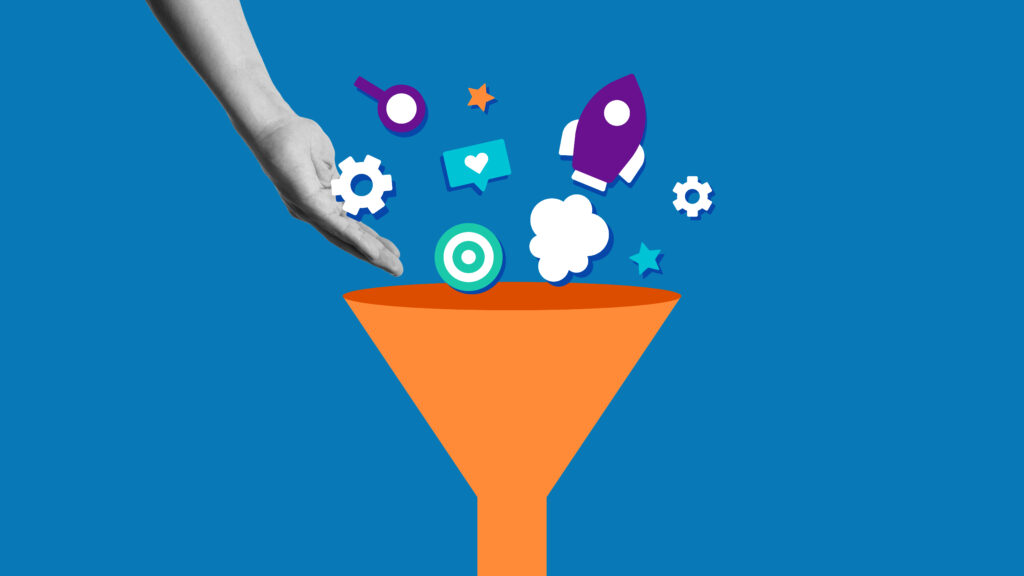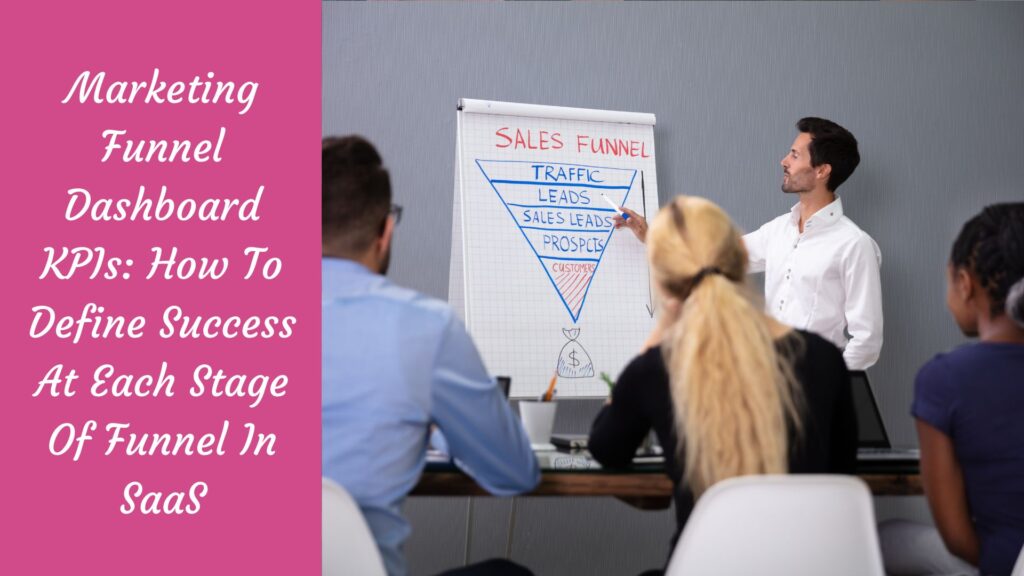SaaS companies operate in a highly competitive environment.
To thrive, they need to leverage every tool available to them. One of these tools is the marketing funnel dashboard, which tracks key performance indicators (KPIs) and helps businesses measure, analyze, and improve their strategies at every stage of the funnel.
This guide will delve into the intricacies of the marketing funnel, its importance in the SaaS industry, and how to define success at each stage.
Understanding the Marketing Funnel
A model that illustrates the customer’s journey towards purchasing a product or service. It consists of several stages, each representing a different phase of the buyer’s decision-making process.

Awareness: The top of the funnel represents the awareness stage, where potential customers first become aware of your brand or product. This can happen through various channels such as social media, blog posts, webinars, or even word-of-mouth referrals. This stage is about attracting the right audience and sparking their interest in your offerings.
Consideration: Potential customers enter the “consideration” stage once they know you. Here, they start to do more in-depth research, compare different solutions, and consider whether your product or service could meet their needs. This is where you must provide valuable content that answers their questions and highlights the unique benefits of your offerings.
Decision: The next stage is the “decision” stage, where prospects are ready to purchase. They’ve compared different options and decided your solution might be the best fit. At this point, they might request a demo, sign up for a free trial, or contact your sales team for more information.
Retention: The final stage, often overlooked but equally important, is the “retention” stage. Here, customers have made a purchase and are using your product. Your goal at this stage is to provide ongoing support, encourage usage, and foster customer loyalty.
The Importance of a Marketing Funnel in SaaS
Unlike traditional business models, where customers make a one-time purchase, SaaS companies operate on a subscription model. This means their revenue depends on acquiring and retaining new customers. The marketing funnel helps SaaS businesses understand their customers’ journey from learning about their products to becoming loyal users.

Moreover, by tracking KPIs at each stage of the funnel, SaaS companies can measure their performance and identify areas for improvement. They can see where prospects drop off, which strategies are most effective at moving people to the next stage, and how well they retain customers.
Defining Success at Each Stage of the Funnel
While the KPIs you track will depend on your business goals and strategy, here are some common metrics that can help you gauge success at each marketing funnel stage.

Awareness Stage
At the awareness stage, you aim to attract as many relevant prospects as possible. Here are some KPIs you might track:
- Website Traffic: This is a basic measure of awareness. By tracking the number of visitors to your website, you can get a sense of how well your brand is attracting potential customers.
- Social Media Engagement: Social media provides a wealth of data about how people interact with your brand. You can track likes, shares, comments, and follows to gauge your content’s level of interest and engagement.
- Content Engagement: If you’re using content marketing to attract prospects, you’ll want to monitor how people interact with your content. This might include blog views, downloads of your resources, time spent on your page, and bounce rate.
Consideration Stage
At the consideration stage, your goal is to nurture your prospects and help them see why your product is the best solution for their needs. Here are some KPIs you might track:
- Lead Generation: This metric tells you how many people have shown enough interest in your product to provide their contact information. This could be through filling out a form, signing up for a newsletter, or requesting a demo.
- Email Open and Click-Through Rates: If you’re using email marketing to nurture leads, you’ll want to track how many people open your emails and click on the links inside. This can give you an idea of how engaging and effective your content is.
- Product Page Engagement: At this stage, prospects will likely visit your product pages to learn more about your offerings. You can track metrics like page views, time spent on the page, and bounce rate to gauge their interest.
Decision Stage
At the decision stage, you aim to convert your leads into customers. Here are some KPIs you might track:
- Conversion Rate: This is the percentage of leads that become customers. You can understand how effective your sales process is by tracking this metric.
- Trial-to-Customer Conversion Rate: If you offer a free trial, you’ll want to monitor how many trial users become paying customers. This can help you understand how effective your trial experience is at convincing users of the value of your product.
- Average Sales Cycle Length: This metric measures the average time it takes for a lead to become a customer. By tracking this, you can identify any bottlenecks in your sales process and look for ways to speed up the cycle.
Retention Stage
During the retention stage, the objective is to maintain customer engagement and promote ongoing usage of your product. To achieve this, you may want to track certain KPIs:
- Customer Retention Rate: This metric tells you what percentage of your customers you can retain over time. A high retention rate indicates that customers find ongoing value in your product.
- Customer Lifetime Value (CLV): This is the total revenue you can expect from a customer throughout their relationship with your business. It’s a key metric for SaaS companies, as it helps you understand how much you can spend on acquiring new customers.
- Net Promoter Score (NPS) gauges customer satisfaction and loyalty. It measures how likely your customers are to recommend your product to others.
How to Monitor Your Marketing Funnel KPIs
Monitoring these KPIs requires a combination of tools and technologies. You might use Google Analytics to track website traffic and content engagement, social media analytics tools to monitor social engagement, and a CRM system to keep track of leads and customers.

It’s important to regularly review your KPIs and adjust your strategies based on what you learn. For example, if your website traffic is high but your lead generation is low, you might need to improve your call-to-actions or offer more enticing lead magnets.
FAQs
What are the key stages of a SaaS marketing funnel?
The SaaS marketing funnel typically consists of five stages: awareness, consideration, conversion, retention, and loyalty. Each stage represents a different point in the customer’s journey, from first becoming aware of your product to becoming loyal. (Source: Userpilot)
What KPIs should be measured at each stage of the SaaS marketing funnel?
Different KPIs are relevant for different stages. For example, you might measure website traffic or social media engagement during the awareness stage. You’d look at conversion rates or cost per acquisition during the conversion stage. Retention could be measured through metrics like churn rate or customer lifetime value. (Source: Search Engine Journal)
Why is it important to analyze SaaS marketing funnel metrics?
Analyzing these metrics helps businesses understand how well they perform at each marketing funnel stage. This allows them to identify areas of strength and weakness and adjust their strategies accordingly to improve overall performance and revenue growth. (Source: Hotjar)
How do marketing KPIs contribute to a SaaS company’s success?
When the right marketing KPIs are in place, they ensure that every effort contributes meaningfully to the company’s overarching success. They provide an objective measure of performance and progress toward goals and can guide strategic decision-making. (Source: The CMO)
What does a SaaS KPI dashboard do?
A SaaS KPI dashboard visually represents key performance indicators, including the conversion rate from one funnel step to the next and the drop-off rates at each stage. This allows businesses to easily monitor their performance and make data-driven decisions. (Source: Userpilot)
Conclusion
Understanding and optimizing your marketing funnel is crucial for success in a competitive industry like SaaS.
By defining and tracking the right KPIs, you can gain valuable insights into your customer journey, improve your marketing and sales strategies, and, ultimately, grow your business.
Remember, the key to a successful marketing funnel is attracting prospects, nurturing them at every stage, and turning them into loyal, long-term customers.

10+ years experience in Marketing and Operations
